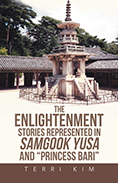
 |
The Enlightenment Stories Represented in the Samgook Yusa and the Princess Bari
by Terri Kim
Trafford Publishing
Well researched and supremely comprehensive, Kim's work immerses readers within a compelling comparison of stories from Korean mythology and the universal themes that resonate among the mythology of other cultures and religions. Using the Samgook Yusa anthology and the shamanic song of Princess Bari, the text gives audiences an understanding of enlightenment in its ultimate form.
Kim offers a thorough scope of the literature already prevalent on Samgook Yusa, providing her own commentary on scholarly articles and viewpoints. She is fearless in her analysis and is unafraid to go against the grain of the literature that is already in existence. At its core, several concurrent themes permeate throughout. Whether it is the dynamic between perennialists—individuals who believe that enlightenment experiences across cultures and religions are adaptations of each other—or the constructivist belief that all are tangentially different, the work's essence is to understand the pathway to enlightenment in its purest form, nirvana.
The clarity with which Kim discusses complex concepts like the Sahasrara chakra or the prajna eye—a direct connection to the "all-knowing" third eye in Hinduism—allows for seamless flow. Her treatise will take readers from Hindu texts like the Katha Upanishad to the depths of Greek mythology. In both, the deity of the underworld—Yama in Hinduism and Hades in Greek mythology—is found shedding light on the pathway to enlightenment. Interestingly, the author parallels the stories of Princess Bari and Cinderella as she highlights how few women achieve the path to enlightenment without a union with their male counterparts. Ultimately, Kim describes the standard form of enlightenment in conjunction with an even higher state, one of absolute self-realization and achieving knowledge of Brahman. Incredibly in-depth, this treatise is a decidedly thought-provoking venture.